Virtual Museum: World War II
Heroes Hall Virtual Museum is a place where residents from Orange County and surrounding areas can share photos of veterans and military memorabilia that holds meaning for them.
Jump to photo collections:
Uniforms & Medals | Correspondence | On the Battle Ground
Those Who Served in World War II
This section tells the stories of local veterans who served in World War II. Veterans are listed in alphabetical order by last name.
Eugene E. Davis
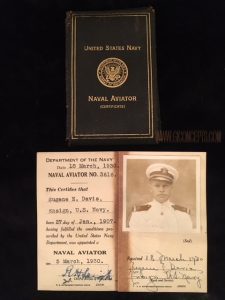
Lt. Eugene E. Davis was a U.S. Navy pilot who was killed on May 23, 1941. He was shot down seven months before the U.S. entered the war, making him one of the first Americans killed in World War II. Davis was serving in England as assistant U.S. air and naval attaché in London. He was flying as a passenger aboard a British Sunderland Flying Boat from Gibraltar to England when it was shot down by German fighters. The British government claimed the plane was “lost” and “gone missing” rather than admitting the large, slow plane carrying government officials was flying alone without fighter escort protection, which made it an easy target for German fighters. It was a careless and embarrassing situation for the British government at the time.
Prior to serving overseas, Davis was stationed at the naval air station in Lakehurst, New Jersey, when Marion C. Cooper, the producer of the 1933 film classic “King Kong,” went there and asked if he could film Navy planes doing acrobatics to use in the final scene of the movie on top of the Empire State Building. Davis agreed and was paid $10 by Cooper. The signed receipt from Cooper is still with Lt. Davis’ personal items today.
Buzz Frazer
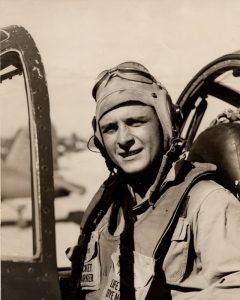
A.C. “Buzz” Frazer was born in East Grand Forks, Minnesota, on May 14, 1924. He enlisted in the U.S. Marine Corps after high school, and at age 19 became one of the youngest fighter pilots in WWII, joining the VMF 113 as a Corsair pilot. After flight school, he married and moved to Brooklyn, New York. For several months, he transported planes from New York to San Diego. He was then stationed at El Toro for several months before being deployed to the Pacific Theater in August 1944.
During the war, he was stationed on Engebi and earned the Distinguished Flying Cross for combat missions in the Ryukyu Islands. Following the war, he received a bachelor’s degree from the University of Minnesota, followed by a master’s degree in mathematics. He spent the bulk of his career at Ford Aerospace in Newport Beach, where he was awarded several U.S. patents. After retirement he became a scuba diver and visited all the top dive destinations in the world.
He passed away on Feb. 25, 2012. He is survived by his five daughters and one son, and was preceded in death by his wife Janet in 2004. More about Buzz Frazer’s military service is available on blurb.com.
David Hayward
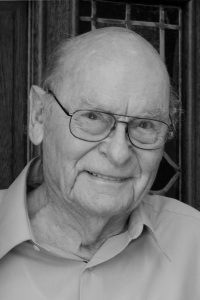
David Hayward was born on May 12, 1922. He was living in Pasadena when he enlisted in the U.S. Army Air Corps in February 1942. He received his pre-flight training at the Santa Ana Army Air Base, where he was one of the first classes to graduate. He went on to become a B-25 pilot serving in the China-Burma-India Theater (Chakulia, India) during World War II. He was assigned to the 22nd Bomb Squadron, 341st Bomb Group, 10th and 14th Air Forces.
Hayward flew 53 combat missions as a pilot of a B-25 medium bomber in the China-Burma-India Theater. From 1943 to January 1944, while at Chakulia, he flew 43 combat missions to enemy-held installations in Burma, aimed at protecting the allied supply line over the Hump from India to China. He faced many hazards including enemy fighter planes, monsoon weather with turbulent clouds and poor visibility, lack of navigational aids, mechanical problems with aircraft, and unfortunate accidents. During 1943 his squadron lost five combat crews and 40 men. Near the end of the war, Hayward served at Bolling Field in Washington, D.C., where he flew high-level military officers on their inspection trips.
Hayward was awarded the Asiatic Pacific Service Medal, Distinguished Flying Cross, and Air Medal with Oak Leaf Cluster. He was discharged from the Army after the war in October 1945.
After leaving the service, Hayward used his GI Bill to earn a bachelor’s degree in mechanical engineering at Caltech and a master’s degree in petroleum engineering at USC. He served 40 years in the oil industry as a petroleum engineer in California. Hayward married Jeanne Thompson, a UCLA graduate, in 1951. They had three sons and four grandchildren. He currently lives in Huntington Beach as an active member of the Freedom Committee of Orange County. Hayward has written two books about his experiences in World War II – A Young Man in the Wild Blue Yonder and WWII Diary – both of which can be purchased at Heroes Hall.
Warren Antonio Escobar
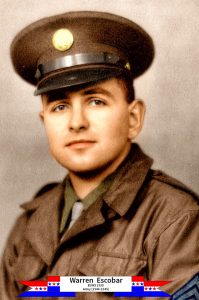 Warren Antonio Escobar was born July 23, 1920, in a house that still stands on Taft Street in Garden Grove, California. Warren and his parents, Anthony Frank and Eva Escobar, moved to Norwalk in 1925 to start a Ford Dealership. Warren graduated from Excelsior High School in 1939, after which he attended Fullerton Junior College, majoring in business. After a year, he changed his major to machinist to be prepared to work in the war effort. To get a draft deferment, he went to work at Douglas Aircraft in Long Beach, where he made the U joint on the landing gear on C-47 airplanes. After a year working there, he was drafted in June 1944.
Warren Antonio Escobar was born July 23, 1920, in a house that still stands on Taft Street in Garden Grove, California. Warren and his parents, Anthony Frank and Eva Escobar, moved to Norwalk in 1925 to start a Ford Dealership. Warren graduated from Excelsior High School in 1939, after which he attended Fullerton Junior College, majoring in business. After a year, he changed his major to machinist to be prepared to work in the war effort. To get a draft deferment, he went to work at Douglas Aircraft in Long Beach, where he made the U joint on the landing gear on C-47 airplanes. After a year working there, he was drafted in June 1944.
In November 1944, Warren was shipped off to Europe on the Aquitania. After a stop in England, they crossed the English Channel and pulled into La Harve, France. He then got on a troop train that crossed into Belgium, where he joined the 28th Infantry Division. Warren’s first battle was the Battle of the Bulge in November 1944.
Fortunately, working at Douglas enabled Warren to postpone his draft and to miss many big battles in Europe. But he entered the Battle of the Bulge to replace the poor souls who perished in that battle. He then fought in two other battles: Central Europe and Rhine River. During these battles, Warren carried 60 and 81 mm mortar.
After the war was over in Germany, the Army was looking for entertainment for the troops. As a clarinet player, Warren could read music, so he volunteered to be in a Glee Club called the Canaries, where he sang baritone. They traveled to different camps and entertained the troops, but their most important song was our National Anthem. They also learned both the Russian and French National Anthems in their native language. Warren left Europe and headed for a 30-day furlough, after which he would be shipped off to the South Pacific. After he arrived in New York, he boarded a train headed for California. They made a stop in Logan, Utah, where Warren saw a newspaper headline that said, “Atom bomb landed in Japan!” No one knew what an atom bomb was but that bomb kept Warren from going on to the Pacific to fight. For the rest of his service, he was stationed in Fort Lewis, Washington. He was discharged in June 1946.
Warren earned the following medals from his service during WWII: Infantry Badge, Bronze Star, European/African/Middle East Area, Victory Medal, Army Good Conduct Medal, and the American Theatre Area Medal.
After his discharge, he joined his father in the Ford Dealership in Norwalk, A. F. Escobar and Son. He worked as a Ford Dealer until they sold it in 1967. Warren married Dorthy Engstrom on Feb. 14, 1942. They had two daughters – Elaine Dee in 1947 and Corinne Kay in 1952. Warren and Dorthy lived in Norwalk until their deaths in 2013 and 2016 respectively.
Wayne T. Hogancamp
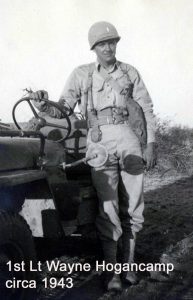
Wayne T. Hogancamp was born on Aug. 18, 1918, in Bardwell, Kentucky. He was drafted into the U.S. Army in 1940 prior to the bombing of Pearl Harbor. In 1942 he was selected for officer candidate school and received heavy machinery maintenance and artillery training. He then spent three months in Arizona on Africa desert maneuvers before being shipped to the South Pacific in 1943, where he served as an infantry cannon unit commander and executive officer. He spent the next two and a half years island hopping in the South Pacific with the Cannon Company, 305th Infantry, 77th Infantry Division. Hogancamp was awarded the Silver Star for his gallantry in action during a mission in Leyte, Philippines in January 1945, and the Bronze Star for heroic achievement during a military operation in the Kerama Islands in March 1945. He separated from the Army on Feb. 9, 1946.
During the Korean War he re-enlisted and served from November 1950 to April 1951 as a training officer in Washington. After leaving the service, Hogancamp moved to Los Angeles, eventually settling in Gardena, where he worked as a tool and die maker and a business owner for 30 years. He and his wife Lillian had three children. Hogancamp died in his sleep on Nov. 3, 2012, at the age of 94.
Bud Kingsbury

Robert E. “Bud” Kingsbury was born on Dec. 9, 1920, in Chicago, Illinois. He joined the U.S. Army Air Force in March 1942 and attended pre-flight training at the Santa Ana Army Air Base and went on to become a B-17 pilot. He was deployed to the Mediterranean during World War II and was assigned to the 2nd Bomb Unit in Tunisia, North Africa. On Aug. 19, 1943, Kingsbury and his crew completed a bombing mission over Foggia, Italy, in a B-17 bomber named “Big Jeff.” On the return back to the base in Tunisia, their plane was attacked by German fighter jets (Messerschmitts). The attack killed five crew members and blew out two engines, causing the plane to plummet toward the sea. Kingsbury and the surviving members of his crew parachuted out of the plane and into Mediterranean. During the fall, Kingsbury lost sight of his fellow crew members and would never see them again. Although he was bleeding from a shrapnel wound to his shoulder, Kingsbury landed in the sea safely and inflated his Mae West life vest. He then began swimming for the Italian coast using the sun to navigate by day and the stars by night. He swam for nearly 30 hours and was hunted by several sharks along the way. To stay strong he thought of his wife Kay and daughter Marianne back at home in the states.
He eventually washed up on the beach in Vallo della Lucania, Italy, and was rescued by three young Italian women. However, it wasn’t long before the German army discovered him, and he was sent to two different Italian POW camps. In October 1943, he was transferred by train to Stalag Luft III in Zagan, Poland, where he spent the rest of the war as a POW. On April 28, 1945, he and his fellow POWs were freed by General Patton’s army, and he participated in the Moosburg March. He was then sent home and was honorably discharged from the service in January 1946. During his tour of duty, Kingsbury was awarded a Purple Heart, Air Medal, Prisoner of War Medal, Europe Africa Middle East Medal and WWII Victory Medal.
After returning to his family in Chicago, Kingsbury struggled with post-traumatic stress disorder (PTSD) and sole survivor guilt until he received treatment from the VA in the late 1960s. As part of his healing process, he was returned to Italy in the 1990s to reunite with the young women who rescued him. The people of the town welcomed him with open arms and honored him. Kingsbury, his wife Kathleen, and his two children settled in Southern California, where he started a career as a plumber, business owner and entrepreneur. He was one of the first plumbers to help build Disneyland. Kingsbury passed away on May 26, 2009.
Kingsbury ‘s story is dramatized in the film Bud’s Odyssey, produced by the Kingsbury family and Emmy-award winning director Mark Kirkland. Through the making of the film, the family has started Bud’s Odyssey Foundation, a non-profit organization that helps veterans find healing from PTSD.
Glen Lunde

Glen Norman Lunde was born in La Crosse, Wisconsin, on March 6, 1922. He entered US Army Air Corps in January 1944. As part of his training to become a waist gunner on B-17 bombers, he spent time at the Santa Ana Army Air Base.
He was assigned to the 336th and 8th Army Air Force, 95th Bombardment Group stationed in Horham, England. He completed 28 missions including the first bombing attacks on Berlin, Germany; an attack on railroad yards in Munster, Germany; and the bombing of an important Messerschmitt fighter plane plant at Regensburg, Germany, which earned him and the entire 3rd Air Division a Presidential Citation. Lunde’s bombardment group, the 336th, was the only one to receive three Distinguished Unit Citations.
On one bombing raid, Lunde recalled that their B17 bomber was running out of fuel, so they made an emergency landing in Belgium. Here a young Belgium man invited him to his father’s farm for a meal. Lunde noticed that the farmer was wearing cardboard shoes with large holes in them, so he took off his new shoes and gave them to the farmer. Lunde never forgot the look of gratitude on the farmer’s face. It stayed with him for the rest of his life.
After the war, Lunde returned to his wife in Wisconsin and they raised four children. Lunde never forgot the beauty and mild weather he experienced in California, so when a job opportunity opened for him, he moved his family to Huntington Park. He had a long career working for Bechtel Corp as a draftsman. Upon his retirement, he volunteered to teach art in underserved schools.
James L. Maloney
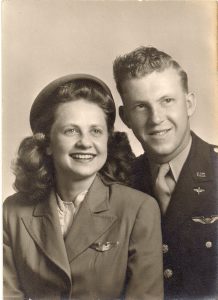
Captain James L. Maloney was born on May 14, 1921, in Fergus Falls, Minnesota. Shortly after graduating from high school, he married his high school sweetheart Margaret Frances Lill-Maloney. He enrolled in private flying lessons and entered the U.S. Army aviation cadet program. On Aug. 5, 1942, at age 21, he enlisted as an officer in the U.S. Army Air Corps. He was sent to the European Theater during WWII, where he flew P-51 aircraft from Italian bases and escorted bombers on their missions to Germany. He flew more than 50 successful missions and was awarded the Distinguished Flying Cross. He separated from active duty on Nov. 30, 1945.
He and his wife moved to Southern California in 1955, where he served in the U.S. Air Force Reserves, attaining the rank of major. He worked in the printing trade in Orange County the remainder of his life and raised six children. After retiring he opened his own printing shop and was known to all his customers as Jim the Printer. Maloney passed away on April 2, 1995, after a long illness.
Pablo R. Ortiz
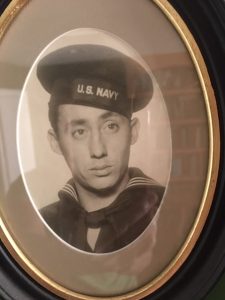
Pablo R. Ortiz was born Nov. 24, 1920, in Mexico City. He joined the U.S. Navy in 1943 and was assigned to the USS Pierce, an Ormsby-class attack transport ship, during World War II. He served in the South Pacific, where he was a part of the Amphibious Force. Ortiz was an electrician’s mate in first class and when in battle, his station was on a flak gun used to shoot down enemy planes.
Ortiz left the service in 1945 and settled in Pico Rivera. He worked as a plant manager for Jan-U-Wine foods in Commerce until his retirement. Ortiz was very active in his church and was in the Spanish choir. Some years after the war, Hollywood depicted his ship, the USS Pierce, in the movie “Away All Boats.” Ortiz passed away on July 7, 2008.
Cruz F. Rios, Jr.
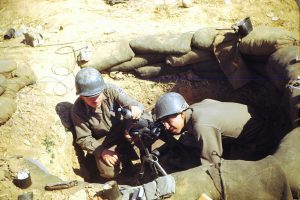
Cruz F. Rios, Jr. was born on Dec. 15, 1918, in Fresno. Prior to his enlistment in the military, he was a welder working on Liberty Ships in Richmond. Then on Feb. 15, 1943, he enlisted in the U.S. Army and served with the 10th Mountain Division, 87th Regiment, Company K as a gunner in a 60 mm mortar crew. The 87th Regiment was the first and one of the only regiments to serve in both the Pacific and European theaters. The 87th was sent to Kiska in the Aleutian Islands in 1943 to fight the Japanese. Then, in 1945, they were sent to Italy to battle the German army.
Rios fell in love with Italy and its people. On leave in Austin, Texas, he was not welcome to many bars and restaurants due to his Hispanic background, but in Italy he was greeted by the liberated Italians with a kiss on both cheeks.
Rios separated from the service on Nov. 2, 1945. He received the following decorations and citations for his military service: Bronze Star, American Campaign medal, European African Middle Eastern Campaign Medal, Asiatic Pacific Campaign Medal and Good Conduct Medal. Following the war, Rios returned to Fresno, married and had three children. He received training as an auto mechanic and eventually owned his own gas station and auto repair shop. Thanks to the mentorship of a fellow WWII veteran, Rios went on to earn his bachelor’s degree in automotive mechanics and eventually became a teacher in the auto mechanics department at Fresno City College. Rios passed away on May 25, 2016.
Shelly Ross
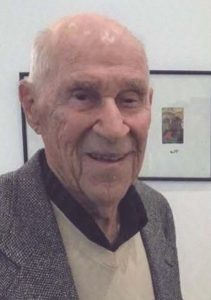
Shelly Ross was born on June 5, 1920, in Cleveland, Ohio. He enlisted in the U.S. Army Infantry in October 1941, but after the bombing of Pearl Harbor, he applied to the U.S. Army Air Corps and was trained at the Santa Ana Army Air Base as a bombardier. After his combat training, he was assigned to the 7th Army Air Force based in Guam. During his tour in the Pacific Theater, he flew with a B-24 bomber crew, completing 40 bombing missions – 35 over Iwo Jima.
The most hazardous missions he participated in were the mining missions, which were done at night over Chichi Jima, a Japanese island just north of Iwo Jima. His crew would start on the Island of Saipan, where they loaded their planes with 1,000-pound mines to be dropped in the harbor. The purpose was to prevent Japan from sending supplies to Iwo Jima. Then they would fly over the harbor at a very low altitude, dropping flares to light up the area. This allowed planes that followed in single file to have clear vision to see their target.
During his time on Guam, Lt. Ross became known as “Lucky” because of his high number of successful missions. Pilots would often request him as their bombardier on their 40th mission, which was the required number of missions to complete before being allowed to return home. Lt. Ross’s squadron was awarded the Thunder Mug Trophy for the most efficient bombing of Japanese Pacific targets. He also earned the rank of 1st Lieutenant and was awarded the Distinguished Flying Cross and eight air medals.
After leaving the service in December 1945, Ross went to law school using his GI Bill. He married his wife Winnie and had three children. He currently lives in Corona Del Mar, and on June 5, 2020, he celebrated his 100th birthday.
Ignacio (Nick) H. Sanchez
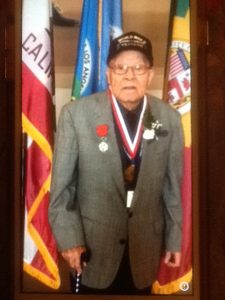
Ignacio (Nick) H. Sanchez was born in El Paso, Texas, on Nov. 16, 1922, and in 1928 the family moved to the Kansas City metropolitan area. Immediately after high school at the age of 17, he enlisted into the Army Air Corps. After basic training in Lincoln, Nebraska, armament school in Denver and gunnery training in Kingman, Arizona, it was off to Salt Lake City to join B-17 crews.
Upon completion of training, Sanchez’s 10-member B-17 crew was ready for World War II aerial combat and assigned to the 8th Air Force base in Chelveston, England, the 1st Bombardment Division, 40th Combat Bombardment Wing, 305th Bombardment Group, 422nd Bomb squadron. He was involved in five major battles in western and northern France, Rhineland, Ardennes and southern France. As a ball-turret gunner, Sanchez made 35 successful missions, including the D-Day invasion on June 6, 1944.
Sanchez returned to the U.S. in February 1945 and married his childhood sweetheart, Mercedes Vargas. He was then assigned to Lubbock Air Force Base. After being discharged from service in October 1945, he returned to his Kansas home and worked for the Santa Fe Railroad for a few years before reenlisting into the Air Force in July 1947. He served with various Bomb Squadrons and then cross-trained into refueling tankers assigned to the 42nd Air Refueling Squadron (SAC). He retired in June 1965 as a Master Sergeant after serving 21 years.
During his service, he earned the Distinguished Flying Cross, Air medal with three Oak Leaf Clusters, Good Conduct with three loops, American Campaign Medal, Europe African Middle Eastern Campaign Medal with five battle stars, WWII Victory Service Medal, National Defense Service Medal, Air Force Longevity Service Award Ribbon with four Oak Leaf Clusters. He was also named a Chevalier (Knight) in the National Order of the Legion of Honor – France’s highest award.
In his civilian life he worked as an assembler for Angelus Machine Shop, retiring again in 1988. Sanchez resides in Buena Park with his wife of 75 years. He has seven children. He is 98.
Howard Snyder
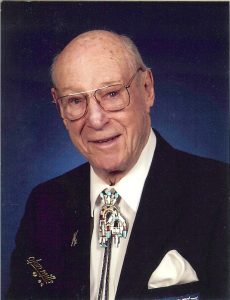
Howard Snyder was born Aug. 6, 1915, and grew up in the Los Angeles area. He joined the U.S. Army Air Force in April 1941 and attended pre-flight training at the Santa Ana Army Air Base. After completing his advanced training to become a B-17 bomber pilot, Snyder was assigned a crew, and on Oct. 21, 1943, he and his crew members reported to the 306th Bombardment Group based at Thurleigh, England, about 60 miles north of London. The 1949 movie classic Twelve O’Clock High starring Gregory Peck was based on a true story about the 306th Bomb Group.
Snyder’s first combat mission was on Nov. 3, 1943, to Wilhelmshaven, and his last mission was on Feb. 8, 1944, to Frankfurt, Germany. On this last mission, Snyder’s B-17, named the “Susan Ruth” after his daughter, was attacked by two German fighters and shot down. Two members of the crew were killed, and the other eight members were able to bail out. Snyder came down in southern Belgium just north of the French border, where two Belgian men came to his rescue before the Germans were able to capture him.
After his rescue, the Belgium Underground moved Snyder from place to place, where he lived with different Belgium families who were brave enough to hide him from the Germans. Finally, he got tired of hiding and joined the French Resistance helping to sabotage German convoys. On Sept. 2, 1944, seven months after the B-17 “Susan Ruth” had been shot down, Snyder met up with American troops that had come up through France after D-Day. After returning to his base and reporting to the 306th Bomb Group in England, Snyder was sent back to the U.S., where he became a B-17 flight instructor until the war ended.
In August 1989, a memorial was erected in honor of and memory to the “Susan Ruth” crew in the village of Macquenoise, Belgium, and Snyder attended the dedication ceremony, where he was reunited with many of the Belgian people who had hidden him during the war. Although Snyder was not the last “Susan Ruth” crew member to die, he was the oldest at 91 in 2007. The story of pilot Howard Snyder and the crew of the B-17 Susan Ruth is told in Howard’s son Steve Snyder’s book Shot Down.
After the war, Snyder returned to his home in Pasadena, California, to his wife Ruth and two little girls and then moved to neighboring San Marino. He owned a restaurant (Snyder’s) in Pasadena and was also the chef for 10 years. After selling the restaurant, he had various sales jobs with his final career job being the exclusive manufacturing rep and then owner of Akra Stamp Machine Company. He and Ruth retired in 1982 and moved to Sedona, Arizona, where they both died in 2007.
Bernard Stein
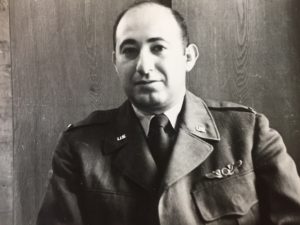
Bernard Stein was born on June 6, 1921, in New York City. After completing his bachelor’s degree in accounting at New York University in 1942, he joined the U.S. Army Air Corps during World War II. He attended pre-flight training at the Santa Ana Army Air Base. Due to a health issue, he was not deployed overseas. After World War II, Stein became a building contractor and developed homes in Queens, New York, but he wanted to return to military life. So he reenlisted in the U.S. Air Force and in 1950, and was stationed in England.
During the Korean War, he was stationed in Okinawa, where he served as radar operator on the B-29 bomber “Command Decision,” named for the popular film about bombers during WWII. Stein’s B-29 bomber was the most-highly decorated bomb crew of the Korean War. They were called the “MIG Killers” for having shot down five Soviet-made MIG fighters during their bomb runs over North Korea. For his role in their successful missions, Stein received the Air Medal with 3 Oak Leaf Clusters. The nose art on their plane was Dopey and Doc, from Disney’s “Snow White and the Seven Dwarfs,” flipping a coin. The fuselage of the plane is on display at the U.S. Air Force Museum at Wright-Paterson AFB in Dayton, Ohio.
After Korea, Stein remained in the military and served as a navigator on B-47 bombers at various bases throughout the country as well as in Morocco. Upon his return to the states in 1962, he was assigned to the Atlas missile system at Forbes AFB in Kansas. He later became a base administrator at bases in Nebraska and Washington, until his retirement in 1967 at the rank of major. Stein was married to Iris Trueheart for 52 years until his death on Dec. 9, 2003. They are buried together at Arlington National Cemetery, and are survived by two sons.
Uniforms & Medals
Photos below were submitted by veterans featured above. This gallery includes photos of uniforms, medals and other recognition these veterans of World War II received.
Correspondence
Photos below were submitted by veterans featured above. This gallery includes photos of war correspondence and publications.
On the Battle Ground
Photos below were submitted by veterans featured above. This gallery includes photos taken during World War II, on location.
















































